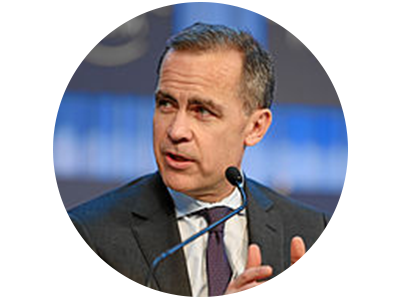Today marks a decisive moment in business’s fight against climate change.
Today, the FSB Task Force on Climate-Related Financial Disclosure (TCFD) launches its draft recommendations for businesses, asset owners, managers, banks and insurance companies to disclose their climate-related financial risks.
The draft recommendations are open for public consultation over the next 60 days.
About the Task Force
The TCFD arose out of Financial Stability Board Chairman Mark Carney’s warning that climate change could significantly impact financial stability.
Taking immediate action, the G20 formulated the Task Force – led by captains of industry like Michael R. Bloomberg – to help business compile and organize the information needed to understand climate-related financial risk.
The TCFD recommendations represent the next step in making sure that businesses are measured by their true cost, true profits, true value – a key strategic focus of WBCSD and our Redefining Value Program.
“Climate change – the risks and the opportunities – are mainstream issues now. They’re important to investors, bankers and asset managers,” says Mary Schapiro, Special Advisor to the TCFD Chair and Former Chair of the U.S. Securities and Exchange Commission.
“Investors see the potential for climate change to impact their investments, and the fact that these risks may manifest in the short or medium term is important,” she says. “[Because of this,] we’ve seen steady increases in investor demands [for more transparency and comparability] on the potential impact of climate change.”
By creating a set of uniform recommendations and guidance, the Task Force has made it easier for businesses to deliver on such demands.
Graeme Pitkethly, Chief Financial Officer at Unilever also sees the benefit. “Climate change is already affecting companies – both through the direct impacts of steadily rising global temperatures and through the policies that governments around the world adopt in response,” he says. “If markets are to operate efficiently we must be transparent, to help investors make better decisions for the long term.”
“What the Framework does is allow companies to give investors the information they’re asking for,” says Schapiro.
What do the Task Force recommendations do?
According to Schapiro, the Task Force is broadly focused on solving three problems:
1) Addressing highly variable methods for disclosing climate change risk
Public companies are already required to disclose material risk, including climate risk. But, until now, there hasn’t been an effective or uniform way to do it.
Creating a framework that fits easily into current methods for financial risk disclosure will help companies understand and report on their climate risks in a more useful way.
2) Increasing clarity for investors, bankers and insurance underwriters
Investors want information on climate-related financial risks so they can make better informed decisions. The same is true for banks and insurance underwriters. Historically, climate risk has not been disclosed or articulated with a financial focus. Task Force recommendations and guidance aim to solve this problem.
3) Understanding the growing impact of climate change and predicting risk intervention for society
Regulators need to understand the potential impact of climate change on the financial system because they need to predict and prepare for regulatory interventions in the future. Understanding climate-related financial risk across various scenarios helps them see where and how best to intervene.
“The goal was to develop a framework that would allow for disclosure to benefit each of these groups” says Schapiro.
Why will the recommendations work and why are they different?
With hundreds of frameworks and sustainability standards available to business, it may be tempting to think of these recommendations as just another set of reporting and disclosure “boxes” to tick, but they’re so much more than that.
Schapiro states that, “Because the standards are voluntary, Task Force members needed them to be decision useful, cost effective and compatible with the existing disclosure structure.” As ever, the ease of implementation will be critical.
“The question for us was ‘How do we satisfy these needs in a way that companies of all sizes and different risk-exposure can integrate?’ Some have climate risks while others have transition risks,” she added.
The Task Force attempted to address these challenges by creating the recommendations for business, by business. The goal was not to reinvent the wheel – in fact, Phase I of the project was spent gathering and leveraging extensive information about the current financial market landscape.
The Task Force’s Phase I report released in March 2016 helped prove that there are thousands of different ways to disclose climate risks, but that very few are related to financial disclosure. Further, most of them are inconsistent, unreliable and/or not comparable.
So what makes this set of recommendations different?
- They’re positioned in terms of financial stability. Many companies already produce sustainability reports because of shareholder recommendations, and these may be written with investors in mind. However, few sustainability reports translate their sustainability information into financial terms. The Task Force recommendations and guidance aim to help fill that gap.
- They’ve been created by business leaders and industry experts from all over the world. The result of their work is a flexible framework that “can be used by any business anywhere of any size” says Schapiro.
- Climate change issues are more mainstream now than ever before. The scientific evidence is indisputable, and the global community is engaged and aligned.
Why should businesses integrate the framework?
“The recommendations are practical. They can be adopted by all organizations, across sectors and geographies, and be included in their financial regulatory filings,” says Pitkethly. The recommendations are based on four disclosure categories that businesses already use: Governance, Strategy, Risk Management, and Metrics/Targets.
The idea is to bring everyone on board - and to do that, the guidelines needed to be simple and easy to implement. The result is an inclusive framework that everyone can start to implement – quickly.
Beyond giving investors requested information, the framework also tries to help businesses conduct sound scenario-planning by offering ways to explore what business would look like under various climate scenarios, including the 2°C scenario.
“It’s not about trying to predict what will happen to business if we surpass 2°C – rather, it’s about trying to lay out a range of possibilities,” Schapiro mentioned. “It’s important for companies who don’t have experience with scenario-planning to learn to discuss it in a quantitative way,” while providing companies who do have more experience an opportunity to go deeper.
A sustainable, low-carbon future is an unprecedented business opportunity for companies who can understand and manage their climate risks. The TCFD Framework will, ideally, allow for better management of these risks, and therefore a quicker translation into climate opportunity.
“This is a framework that can work very well for business,” Schapiro explains. It isn’t just about risks, it’s also about opportunities.
The appetite for such a framework is palpable. There were over 1000 participants in Phase I – and Task Force members expect strong uptake during the public consultation period of Phase II.
What’s next?
The TCFD recommendations could be the next step forward in shifting the global economy so that it’s measured by true costs, true profits, and true value.
Encouraging companies to examine their relationship with climate change will enable them to explore risks they may never have fully realized before, with many positive benefits.
This framework has the potential to inspire a “race to the top” as companies compete to gain control over sustainable products, markets and services; spurred innovation - as companies are pushed to address new and previously unknown risks; and progress in addressing climate change as the “biggest market failure the world has ever seen (Stern, 2007).”
Climate change will impact all companies, and this impact will manifest itself indifferent ways for different stakeholders over various time horizons. It is important for all of us, as stakeholders in both climate and economy, to assess, understand and disclose our climate risks in a transparent and comprehensive way.
“Many companies do face these risks and it would not be wise to discount or ignore them,” said Schapiro. It’s clear that the new recommendations and guidance are a giant leap in the right direction.
Given the major role that the private sector has to play in addressing climate change and remaining under the 2°C limit, business cannot afford to ignore these risks any longer. As Pitkethly says, “We will be working towards adopting the recommendations, and we hope that all businesses will be forward thinking and adopt these recommendations too.”
See WBCSD and the We Mean Business Coalition’s formal statement about the draft recommendations here.











